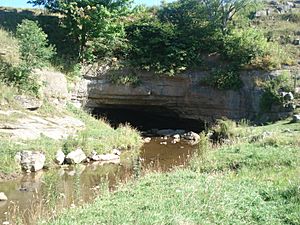Greenbrier Group facts for kids
Quick facts for kids Greenbrier LimestoneStratigraphic range: Middle Mississippian |
|
|---|---|

The Sinks of Gandy (an underground stream) is developed in the Greenbrier Limestone Formation in West Virginia.
|
|
| Type | sedimentary |
| Sub-units | Denmar Limestone, Taggard Shale, Pickaway Limestone, Union Limestone, Greenville Shale, and Alderson Limestone. |
| Underlies | Bluefield Formation |
| Overlies | Maccrady Formation and Price Formation |
| Thickness | 120 m |
| Lithology | |
| Primary | Limestone |
| Location | |
| Region | Allegheny Mountains |
| Country | United States |
| Extent | Kentucky, Maryland, Virginia, and West Virginia |
| Type section | |
| Named for | Greenbrier River |
The Greenbrier Limestone, also known as the "Big Lime," is a very large rock layer found deep underground. It is a type of limestone that formed a long, long time ago, during the Middle Mississippian period. This was about 345 to 326 million years ago!
This special rock layer is found mostly beneath West Virginia and parts of Kentucky. It also reaches into western Maryland and southwestern Virginia. The Greenbrier Limestone gets its name from the Greenbrier River in West Virginia.
Contents
What is Greenbrier Limestone?
Greenbrier Limestone is a type of sedimentary rock. This means it formed from layers of tiny bits of shells, sand, and mud that settled at the bottom of ancient seas. Over millions of years, these layers were pressed together and turned into rock.
How Thick is This Rock?
In some places, the Greenbrier Limestone is incredibly thick, more than 400 feet (120 meters)! Because it's so thick and has tiny spaces inside, it can trap large amounts of oil and natural gas. These are important energy sources.
Why Don't We See It Often?
Limestone is a soft rock that wears away easily, especially in wet places. This means you don't often see big parts of the Greenbrier Limestone sticking out of the ground. When it is found near the surface, it is often dug up from quarries for use in building materials or other products.
Layers Within the Greenbrier Limestone
The Greenbrier Limestone isn't just one solid layer. It's actually made up of six smaller rock layers, one on top of the other. These layers are called:
- Denmar Limestone
- Taggard Shale
- Pickaway Limestone
- Union Limestone
- Greenville Shale
- Alderson Limestone
Most of these layers are made of limestone. They contain tiny pieces of ancient shells and other sea creatures. Some parts, like the Pickaway and Union layers, have tiny round grains that look like fish eggs.
Caves in the Limestone
One of the coolest things about the Greenbrier Limestone is that many caves form within it. Because limestone dissolves slowly in water, rainwater seeps into cracks and creates amazing underground passages and caverns over time. The famous Sinks of Gandy in West Virginia, shown in the image, is an example of a stream that goes underground into a cave system in this very rock formation.

